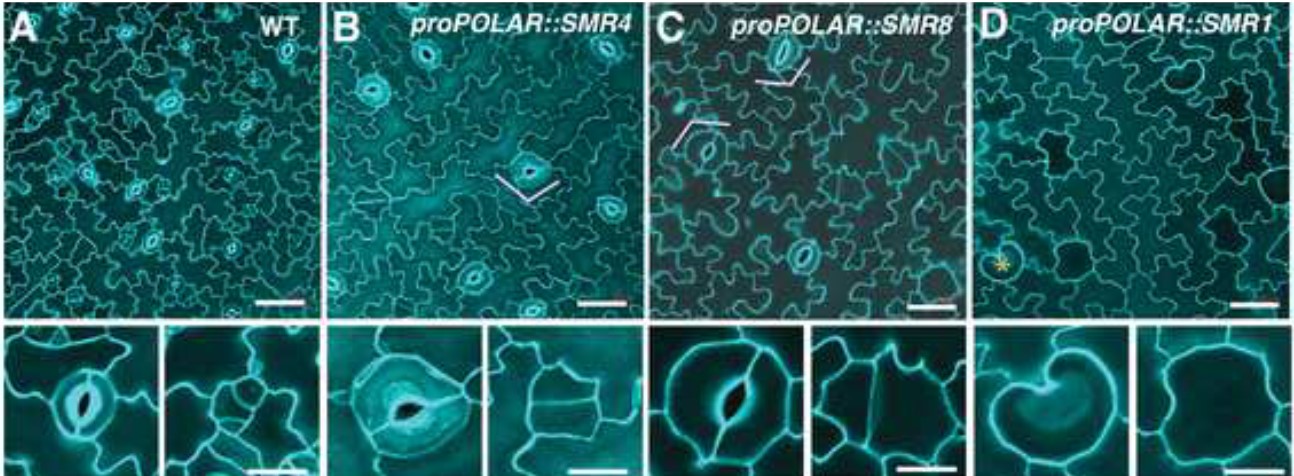Unraveling How One of the Most Important Cell Types Form

Scientists studying plants have uncovered a key part of the process that forms one of the most important cell types on Earth.
Stomata are a type of cellular valve found on the surface of plants that allow gases, like carbon dioxide and oxygen, to flow in and out of the plant. Under a microscope, these cells can look like tiny mouths, opening and closing as the plant regulates gases and water in its tissues. Scientists have long sought to understand, as plants grow from seeds to seedlings and mature plants, how do some cells become stomata while others become roots or stems?
In a paper out today in the Proceedings of the National Academy of Sciences, researchers at the University of Texas detail how a key protein, nicknamed SCREAM, partners with three other proteins to determine which cells in a growing plant will become key stomata cells.
"This cell type, stomata, is critical for plant survival," said Keiko Torii, professor of integrative biology at The University of Texas at Austin. "It's also critical for most of the food we eat and the air we breathe. We wanted to understand the mechanism by which precursor cells become stomata and what kind of impact environmental factors have on that."
By altering the way these different proteins are expressed in mustard seed plants, the researchers were able to observe what happened and the results were eye-opening.
The three proteins that interact with SCREAM have been given acronym names of their own: SPEECHLESS, MUTE and FAMA. When mutants were bred without the SPEECHLESS protein, the plants had no stomata cells and essentially couldn't breathe. When mutants were bred that overproduced the MUTE protein, the surface of the plant was all stomata cells.
During experiments, researchers uncovered that the SCREAM protein interacts with the other proteins in a specific order with unique strengths to produce mature stomata cells that operate correctly. (First comes SPEECHLESS, then MUTE and finally FAMA.) By slightly tweaking the structure of SCREAM, the researchers produced a version that still interacts with SPEECHLESS and FAMA, but not with MUTE. The resulting effects are massive stem cell arrests.
Torii began the initial work that led to these findings more than a decade ago, and she is considered a world expert in stomata cells. However, for this paper two interdisciplinary researchers with different backgrounds—a graduate student and a visiting researcher in her lab—helped push the research to publication.
Hyemin Seo is a graduate student in Cell and Molecular Biology and her previous research focused on muscle development in zebrafish.
"I was interested in understanding how stem cells become muscles, and it's interesting to see the parallels between plants and animals and how stem cells differentiate," Seo said. "Having that background can bring a new perspective."
Krishna Sepuru, a visiting researcher at UT Austin with a background in biophysics, cancer research and immunology, also contributed.
"These findings in plants can easily translate to animals," Sepuru said. "If we can better understand how stem cells are converting to different cell types, what factors affect that and even how to regulate that process, that's extremely useful."
Aarthi Putarjunan of UT Austin, a former UT Austin undergrad Lyndsey Aguirre, who did summer research internships at the University of Washington, and Benjamin A. Burrows, a former undergrad of the University of Washington, also contributed to the research. The research was funded by the National Science Foundation and the Howard Hughes Medical Institute.
In a related paper in Developmental Cell, Torii and researchers in her lab unraveled additional clues about the molecular framework that turns precursor cells into stomata cells and how speed and timing of the process is controlled.
A key molecule called SMR4, a type of cell cycle inhibitor, is induced by MUTE, the protein mentioned in the earlier paper, and acts to slow down the stem cell divisions to switch to the differentiation. By contrast, SMR4 fails to interact with other proteins involved in later stages of the cell development process, allowing the final division that create a stoma-- a pore surrounded by paired guard cells.
"This shows us that timely introduction of these critical molecules is an important part of the stem cell differentiation to make stomata cells," Torii said.
Soon-Ki Han and Rie Iwasaki of Nagoya University, Arvid Herrmann, Jiyuan Yang and Eun-Deok Kim of UT Austin, Tomoaki Sakamoto and Seisuke Kimura of Kyoto Sangyo University and Bénédicte Desvoyes and Crisanto Gutiérrez of Centro de Biologia Molecular Severo Ochoa also contributed to the research.



